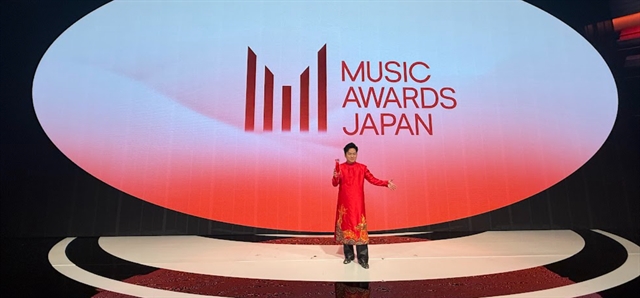A new generation of artists is drawing attention from global audiences and gradually strengthening Việt Nam’s presence on the international music scene.
HÀ NỘI - Vietnamese music is gaining ground internationally, driven by a new generation of artists who are reinterpreting tradition with a fresh twist.
Their work is drawing attention from global audiences and gradually strengthening Việt Nam’s presence on the international music scene.

Singer Phương Mỹ Chi performs the mashup tune 'Lý Bắc Bộ' at Sing!Asia 2025. Her performance stood out for its creative blend of folk influences. Photo courtesy of Sing!Asia
One notable example is 22-year-old singer-songwriter Phương Mỹ Chi, who recently performed at Sing!Asia 2025, the first cross-border music competition organised by China’s iQIYI. The event brought together 32 emerging vocalists and judges from nine Asian countries.
Her performance of Lý Bắc Bộ, composed by producer DTAP, stood out for its creative blend of folk influences. The song draws on the cultural life of northern Việt Nam and includes elements from Đẩy Xe Bò (Pushing the Cow Cart) – a folktronica piece that merges pop, house, and folk traditions. The work was inspired by writer Kim Lân’s short story Vợ Nhặt (Picked Wife).
Throughout the performance, Phương Mỹ Chi incorporated the ornamentation and vocal nuances of Bắc Ninh’s quan họ (alternate folk singing), giving the piece a distinctive texture. She also performed a traditional trống cơm drum dance, which added energy to the stage and engaged the judges.
Chi said the concept was developed through close collaboration with her team, aiming to highlight both their creativity and a youthful approach.
DTAP explained that the choice of Lý Bắc Bộ was shaped not only by musical ideas, but by the intention to convey a form of Vietnamese intangible cultural heritage recognised by UNESCO.
“Music isn’t just for listening – it’s a way to tell stories, build connections and maintain identity,” DTAP said.
He praised Chi’s ability to express emotion while keeping technical precision, noting that this combination helped her deliver a performance rooted in cultural understanding.

Rapper 7Dnight (left) and his mentor BigDaddy at Rap Việt 2024. Photo courtesy of Vie Channel
In recent years, Vietnamese music has expanded its reach abroad. Tracks like Không Sao Cả (No Problem) by rapper 7Dnight – first presented on Rap Việt 2024 – went viral, with over a billion views on TikTok.
Other popular songs such as Si Tình (Lovesick) by Hoàng Thùy Linh, Vũ Trụ Có Anh (Have You in This Universe) by Chi, Hai Phút Hơn (More Than Two Minutes) by rapper Pháo, and Dễ Đến Dễ Đi (Easy Come Easy Go) by Quang Hùng MasterD have also gained attention across digital platforms.
These examples reflect a broader trend of Vietnamese music combining local identity with broad appeal.
To achieve long-term recognition beyond viral success, many say Vietnamese music needs a clear creative direction and the ability to adapt to a global landscape.
This transition is being shaped by a younger generation of artists who mix traditional themes with modern sounds, contributing to the development of a distinct cultural voice.

Divo Tùng Dương receives the prestigious International Special Award at Music Awards Japan. Photo courtesy of MAJ
One such artist, divo Tùng Dương, was recently honoured at the Music Awards Japan for his original style and commitment to cultural integrity – further evidence that Vietnamese music is gaining respect from international institutions.
Composer and producer Quốc Trung believes the future of Vietnamese music will depend on consistent quality, artist vision, and an environment that encourages artistic freedom.
“Reaching a global audience is entirely possible if we support long-term creative strategies,” he said.
Vietnamese artists today are growing up in the digital era, navigating international trends while staying connected to their cultural foundations.
Their approach may be quiet, but it’s helping Vietnamese music find and keep its place in the global conversation. VNS